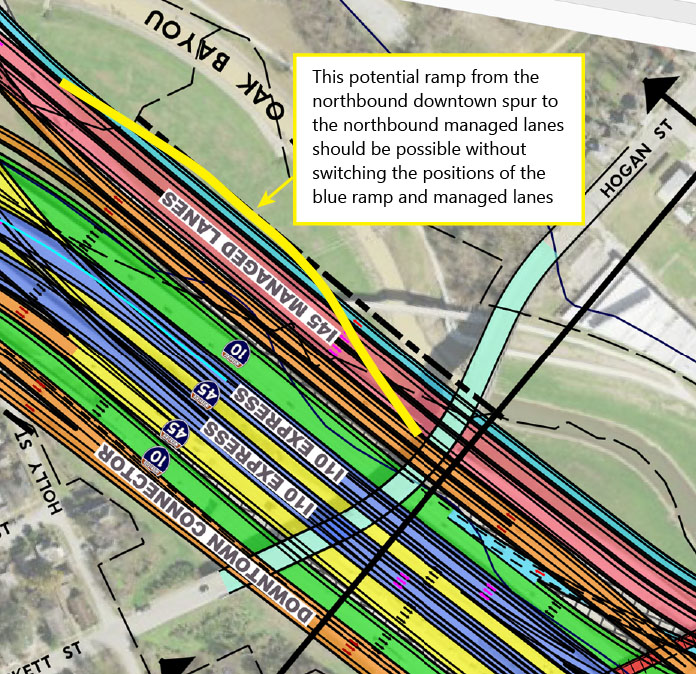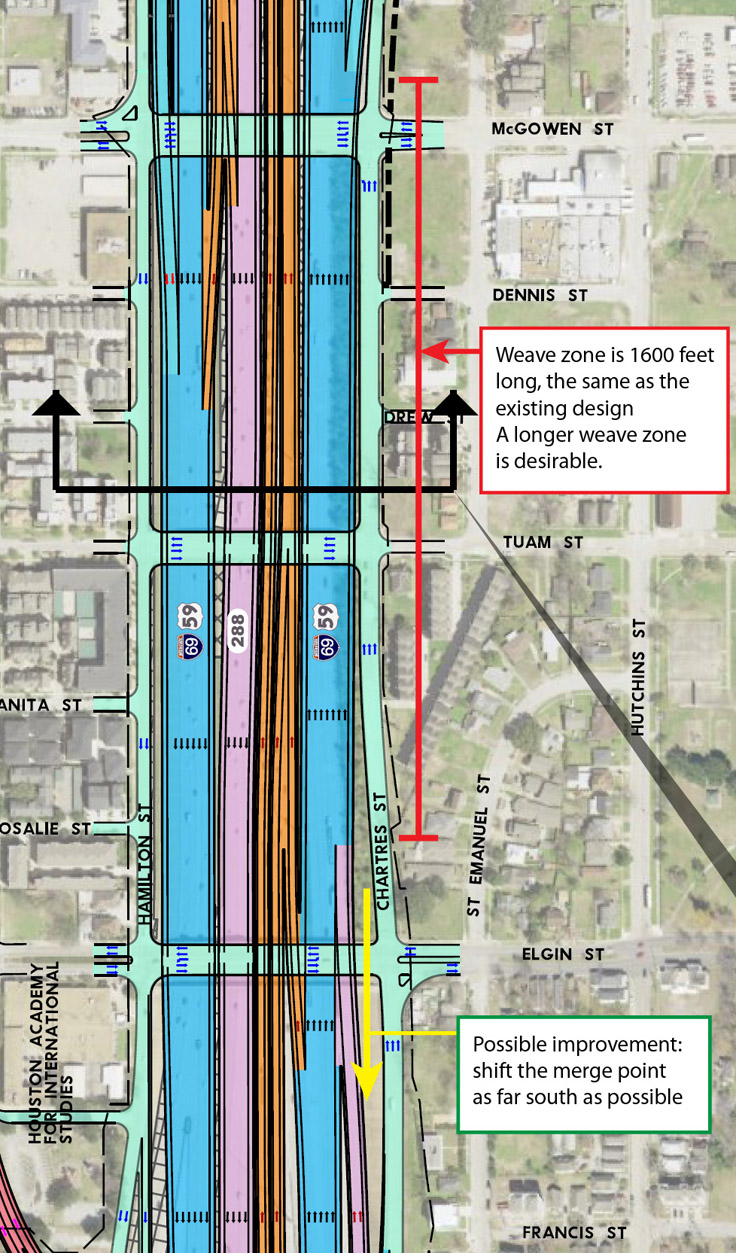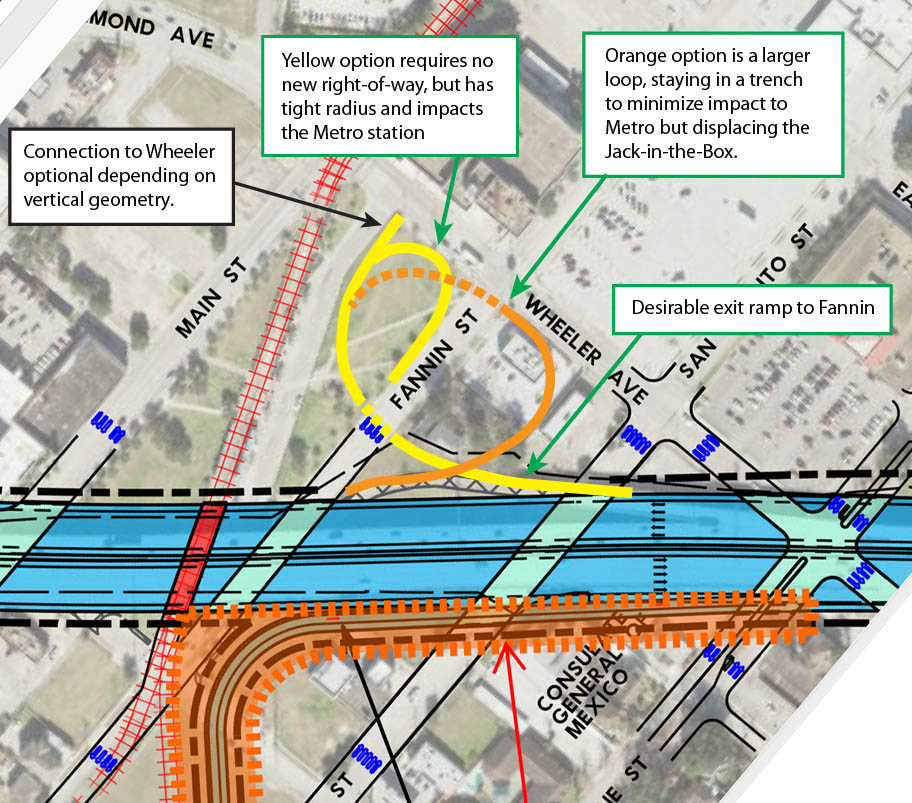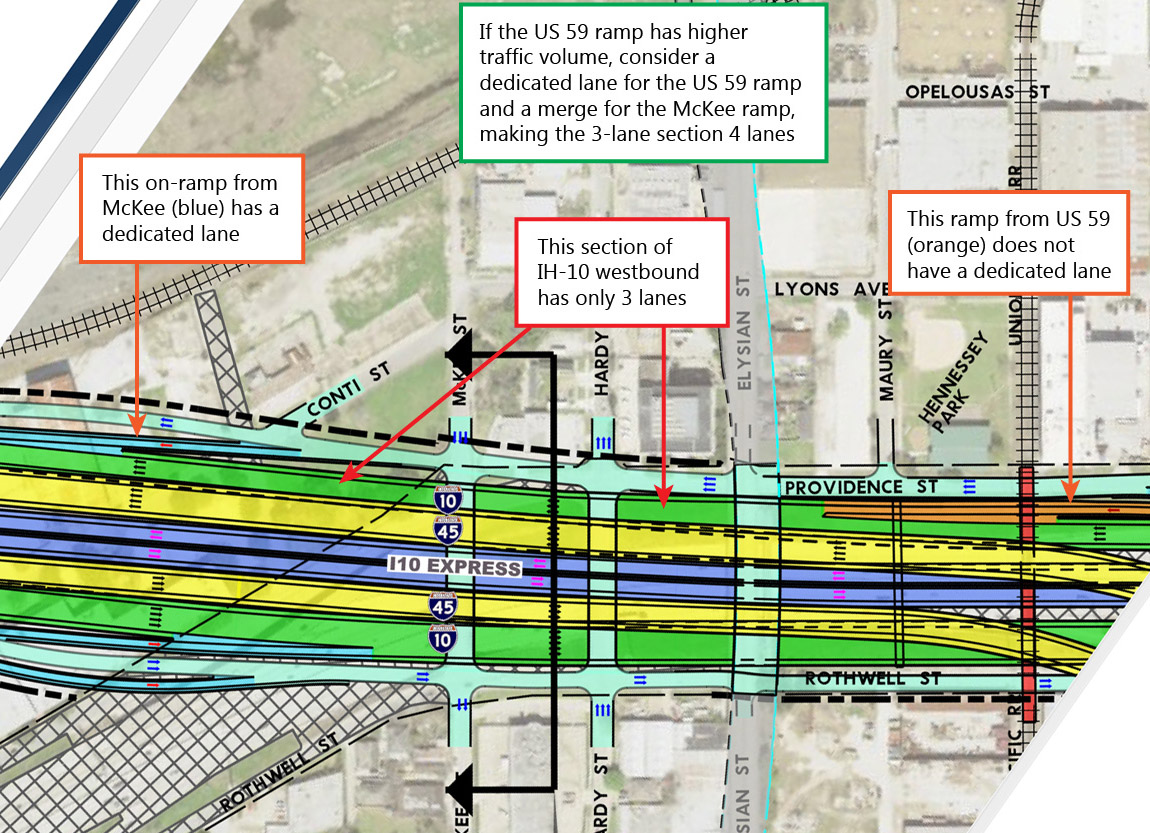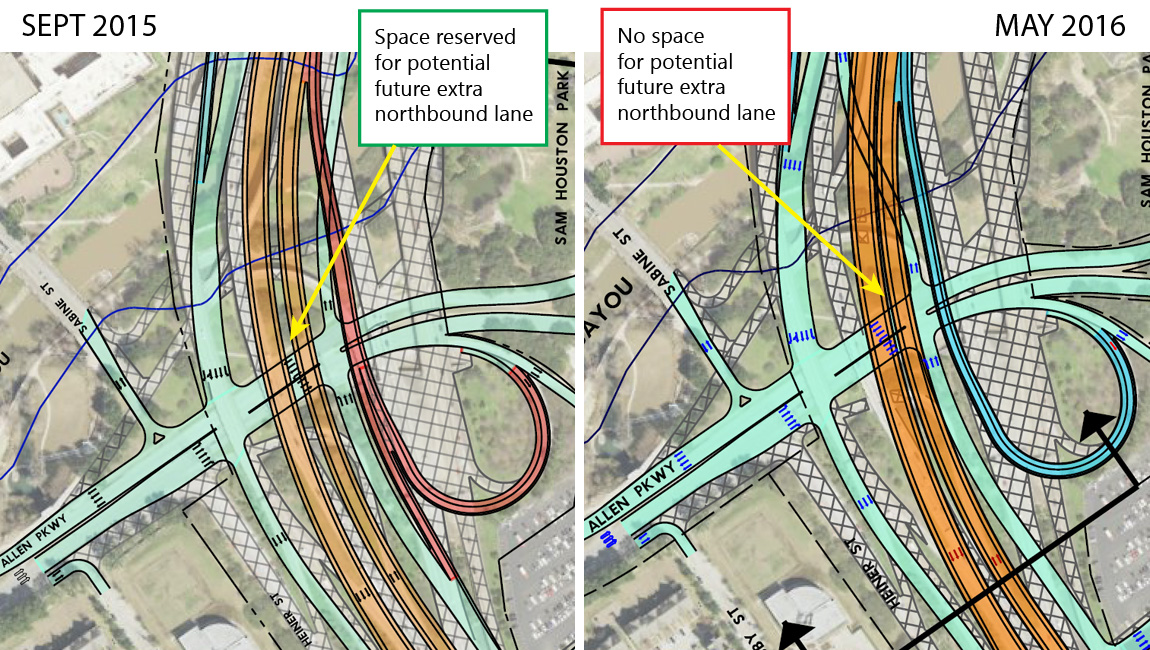
ARCHIVE Analysis, Critique and Suggested Modification
for the Proposed Improvements to Downtown Freeways and I-45 North
May 26, 2017 Update: This analysis is obsolete since TxDOT posted revised schematics in May 2017. This archived version is retained for reference.
See the updated analysis posted online in May 2018.
Page created May 10, 2015 Major update June 25, 2016
Official TxDOT Project Web Site
Comments and feedback: Houston@oscarmail.net
TxDOT placed updated schematics online for the inner-loop part of the project in May 2016. This was the second update, after the original release in April 2015 and the first update in September 2015.
The September 2015 update was a huge improvement over the original plan, and the May 2016 update provided another big improvement to the design.
See the status of the September 2015 concerns and the September 2015 detailed list, and the status of the original problem list items.
I'm pleased to report that my list of concerns continues to shrink and I now have only four items of concern relating to design, and three ideas for consideration.
I appreciate TxDOT's efforts to refine the design to make it the best that it can be.
New and Remaining Concerns for the May 2016 Schematics
Ideas for consideration
IH-45 northbound and southbound, new entrance/exit to the managed lanes at Loop 610 is poorly situated and jammed into a constricted space
The previous design lacked an entrance/exit to the managed lanes inside the loop, but the location and design of this new entrance/exit is not good.
Problem
- The northbound entrance/exit to the MaX lanes is located at the exit for the connections to the North Loop. Traffic congestion usually occurs at interchange exit points. Now to further complicate this location, the MaX lane entrance is added at this spot.
- Vehicles positioning to enter the managed lanes will be weaving to the left, causing more lane-switching in an already congested area.
- Both the northbound and southbound entrance/exit zone is very tight with no shoulders and minimal buffers. There is minimal space between the edge of the lane and pylon separators. (Pylons would likely have a short life.) It will be safer to have a shoulder and/or wider buffers, like the well-designed entrance/exit zones on the Katy Freeway managed lanes.
Potential Solution
- Move the northbound managed lanes entrance/exit to be between Cottage Street and Patton Street, since properties are already being acquired and widening the right-of-way would have no additional impact. Also add buffer space and/or a shoulder along the managed lanes entrance/exit.
- Or, remove the northbound slip ramp entirely and replace with direct connections, as suggested in item 3 below.
- For the southbound entrance/exit zone, widen the bridge to provide a wider buffer and/or shoulder to improve safety and driver comfort. Possibly move the entrance/exit zone north to be farther away from the merge point of the connections from Loop 610.
TxDOT Response
"Concur that we need to improve this access point. We are looking into direct connections to/from I-10 and the MaX lanes to replace the existing HOV/HOT access points near Quitman that will eliminate these slip ramps. If these slip ramps must remain, we will implement your solution during the during the FEIS phase as it will require additional Right of Way on the southeast corner of the IH 610 interchange."
Outlook
- We can expect to see improvement to this situation. The direct connection from IH-10 sounds promising, but ideally there should also be access from the downtown spur and the northbound IH-45 main lanes.
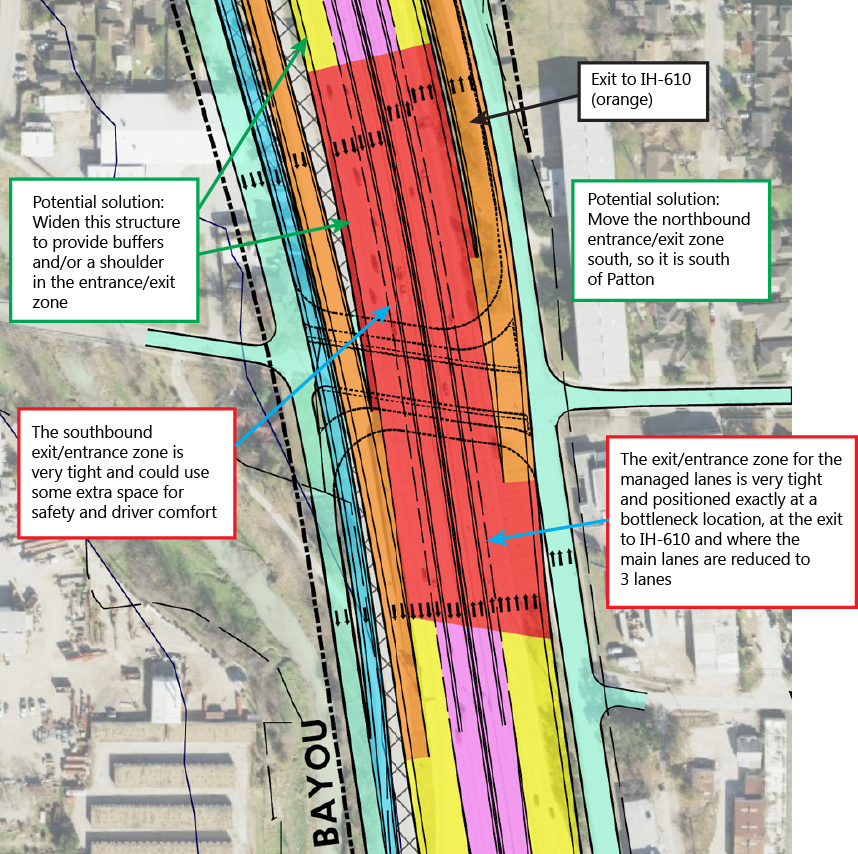
Potential Solution:
IH-45 Northbound at Loop 610 is Reduced to Three Main Lanes, the Same as Currently Exists
This concern has existed since the original plan, but I have not mentioned it previously since there were more pressing issues to address. But now that the managed lane access point problem (item 1 above) has been introduced to this location, it is probably a good time to review if an adjustment can fix this concern.
There is heavy traffic volume going northbound on IH-45, and there is normally traffic congestion south of Loop 610 due to this bottleneck location. The managed lanes will help with this problem, but the managed lanes have poor access in the current plan (see item 3 below).
Problem
- IH-45 Northbound is reduced to three main lanes at Loop 610
Potential Solution
- Maintain four northbound main lanes. This will require an extra auxiliary lane south of Loop 610, and the entrance from the frontage road would not have a dedicated lane, but would be merged into the four main lanes.
TxDOT Response
"Concur. As noted in our response to No.1, we are looking into direct connections for the MaX lanes that will eliminate these slip ramps and allow for an additional lane while limiting the additional Right of Way."
Outlook
- Improvements for this issue will be dependent on the adjustment for item 1, and hopefully the fourth northbound lane over Loop 610 will be added.
IH-45 Northbound Managed Lanes: Insufficient Access Inside the Loop
This item is retained from the original problem list and the September 2015 list. Unfortunately there has been no progress on this problem, possibly because it was determined to be technically infeasible or cost prohibitive. This is a difficult problem, no doubt.
But I still believe there is a need for at least one additional entrance, and I think there are potentially feasible options to be considered.
But I still believe there is a need for at least one additional entrance, and I think there are potentially feasible options to be considered.
Problem
- There is only ONE access point to the northbound managed lanes inside the loop, from Travis Street downtown
- Traffic on the northbound IH-45 main lanes, northbound on the downtown spur and westbound on IH-10 cannot get on the managed lanes until the entrance at the North Loop.
- Since there is normally a heavy traffic backup inside the Loop between downtown and Loop 610, motorists should have the option of better access to the managed lanes to avoid the traffic jams
Potential Solution
- Ideally, both the northbound downtown Spur and IH-45 northbound main lanes should have access to the managed lanes in the downtown area.
- It appears to be feasible to add a connection from the northbound downtown Spur to the northbound managed lanes with the current configuration (see diagram)
- To add an entrance to the managed lanes from IH-45 northbound or IH-10 westbound, I propose to switch the position of the two managed lanes and the long entrance ramp to the main lanes from Travis Street, so that the entrance ramp is on the inside and the managed lanes are on the outside (see diagram)
- If an additional downtown entrance to the managed lanes is not feasible, shifting the northbound access point to the area south of Patton as suggested in item 1 would help mitigate this problem
The September 2015 plan also lacks a connection from the southbound managed Lanes to the southbound downtown Spur. I feel that connection is less urgent because main lane backups are more likely in the northbound direction.
TxDOT Response
"We agree that it would be good for motorists traveling northbound on IH-45 to have direct access to the northbound MaX lanes. We looked extensively into adding access from both the Spur and IH-45, but there are too many levels/movements to make this a direct connection.
"As noted in our response to No. 1 and 2, we are looking into direct connections for the MaX lanes to/from IH-10 westbound (toward the Galleria) that will eliminate the slip ramps south of IH-610 and provide better access. Metro also commented on this and we met with their leadership the week of 6/13/16 to brief them that we were looking into removing the slip ramps and replacing with direct connections."
Outlook
- Improvements for this issue will be dependent on the adjustments for items 1 and 2. I expect to see some improvement, although it will likely fall short of the ideal connections to the northbound MaX lanes, including the downtown spur, IH-45 northbound main lanes and IH-10 main lanes.
- I still think my potential solutions in the diagrams are feasible at a reasonable cost.

SH 288 Northbound merge into Northbound IH-69 Could Potentially be Lengthened
The proposed design is very similar to the existing freeway, which has a weave zone about 1600 feet long where IH-69 vehicles exiting to Gray Street move to the right and SH 288 vehicles connecting to IH-69 north move to left.
This zone probably has the most weaving and merging in a short distance in the entire proposed plan.
When I drive through this weave zone, it can be difficult and stressful to navigate, so ideally we would have a better design. Options are limited due to vertical geometries, however.
Problem
- This area will have heavy weaving and merging, and the weave/merge zone length is less than ideal
Potential Solution
- Move the merge point of the lanes from SH 288 as far south as possible to lengthen the weave/merge zone.
- The length of a southward shift is limited since SH 288 goes over Alabama Street. Possibly use low-profile beams over Alabama to reduce the elevation by two or three feet to get the SH 288 lanes to the IH-69 level faster.
TxDOT Response
"Concur that this is the most challenging weaving segment in the project and it was thus a big focus on developing an overall solution to reduce the associated congestion. As noted on earlier responses, the most beneficial improvement we implemented is swapping the positions of US 59/IH 69 and SH 288."
"However, we could not remove all weaving sections and the one you noted is the last remaining weave. Agree that a longer weaving distance would be ideal here, but we are constrained by the SH288 northbound vertical and horizontal geometry. We tested this section with the detailed traffic model (VISSIM) does not show a major weaving issue in this area due to the additional access points provided to/from downtown by the Proposed Recommended Alternative."
Outlook
- It appears that TxDOT feels adjustments at this location are not needed and not feasible, so changes are very unlikely.
Extremely expensive cost for the downtown improvements, possibly unaffordable or not cost-effective
In June 2015 the Houston Chronicle reported that the estimated cost of the downtown section of the project is
a mind-bogging $4 billion, and the project north of downtown is estimated at $3 billion, for a total of $7 billion. The article also reported that the downtown section will proceed first.
For comparison, the 35-mile-long US 290 project currently in progress from 2013 to 2017 has a total cost of $2.4 billion and a construction cost of $1.3 billion. The 25-mile-long Katy Freeway expansion built from 2002 to 2008 cost around $2.7 billion, which would probably be around $3.2 to $3.5 billion in 2016 dollars.
Observations
- The downtown section of the project is the main budget buster at $4 billion
- Accommodating the desires of downtown Houston interests and inner loop interests caused the cost of the downtown section to skyrocket. Also, this analysis has likely influenced many design adjustments which also incrementally increased the cost.
- The 12-mile section north of downtown, estimated at $3 billion, is more reasonably priced.
- The HGAC TIP financial plan reports that during the four fiscal years from 2017 through 2020, funding for federal and state highway programs is $4.68 billion, or $1.17 billion per year. That amount covers all construction, maintenance, operations and administration in the six-county Houston District, and appears to also include right-of-way funds (although I am not sure about that).
- I'm thinking that around $700 per million year is available for new projects.
- At current funding levels, the downtown section would consume all available Houston-area construction/right-of-way funding for around 6 years and everything north of downtown would consume 4 years of funding, for a total of around 10 years if the project could get all available regional money. Since other priorities will also need to be accommodated, this project could require 15 or more years to complete after construction begins.
- Increased state and/or federal funding would expedite the project. Both Clinton and Trump are calling for increased infrastructure investment, but getting the funding would require a federal gasoline tax increase, which is unlikely to clear congress.
- Some bonds could be issued based on revenue from the MaX lanes. I'm thinking maybe $250 million, which is around 4% of the overall project cost but around 8% of the project cost north of downtown, where the MaX lanes are actually located.
- The section of IH-69 from Spur 527 to SH 288 is slated to proceed first. I fully agree with that plan.
- After the IH-69 section, I prefer to see more cost-effective sections proceed next. That would be the section from Loop 610 to Beltway 8, including the IH-45/IH-610 interchange.
- For downtown (after the IH-69 section between Spur 527 and SH 288), I would prefer to see IH-69 improved and sunk into the trench, leaving IH-45 and IH-10 mostly intact. That should cost in the range of $1 to $1.5 billion if the US 59/IH-10 interchange can be preserved. For that money, IH-69 would get its vaunted 24 mph speed increase and downtown interests would get the freeway sunk below ground level. And it has a price tag which can be funded.
Ideas for Consideration
These items could warrant a closer look for added benefits.
Southbound IH-69 Exit Ramp to Fannin
Problem
- The exit to Fannin is eliminated and replaced with an exit to Almeda Road. This will force vehicles through six traffic signals to reach Fannin using a route with two turns.
- Proceeding to the west from the Almeda exit will be difficult and inconvenient since east-west streets are not equipped to handle through-traffic
Potential Solution
- Add an exit to Fannin using a loop design.
- This can be done with no further acquistion of private property by using the yellow option in the diagram. The orange option would meet design standards but would cost more and require the displacement of the Jack-in-the-Box restaurant.
- The loop ramp to Fannin will replace the functionality of the exiting exit to Fannin, providing excellent access into this area where people are actually going, and also providing much improved access to points to the west, including Montrose.
TxDOT Response
"Agree that it would be good to provide an exit to Wheeler and Fannin. We looked at a similar ramp on previous versions, but could not make it meet required design criteria. However, since the mainlanes are depressed, a ramp in this location will have to remain depressed under Fannin and then quickly climb to meet street level. A ramp in this location would also adversely impact Metro’s Wheeler Transit Center utilities and operations."
Outlook
- TxDOT has considered this and determnined that it is not feasible.
- I still think the exit at Almeda for southbound traffic is going to cause problems due to most traffic moving west from that exit and the inadequate/inconvenient street system for moving westbound traffic.
- I think that a design exception, such as a tight-radius loop or higher-than-usual vertical incline, is justifiable to get the benefits of this exit.
IH-10 westbound: Possibly Provide a Dedicated Lane for the Ramp Connecting from IH-69
This idea depends on which ramp has higher traffic volume, the ramp from IH-69 or the entrance ramp from McKee Street. If the IH-69 ramp has higher volume, an adjustment could be warranted.
Possible Item for Improvement
- The exit from IH-69 to westbound IH-10 merges into the 3-lane IH-10 main lanes
- Just to the west, the entrance ramp from McKee Street has a dedicated lane
Potential Change
- If the ramp from IH-69 has higher traffic volume, then the ramp from IH-69 should have a dedicated entrance lane and the ramp from McKee should be merged into IH-10 without a dedicated lane
TxDOT Response
"Concur that it would be good to have a dedicated lane coming from IH 69, but we are constrained by Right of Way and adjacent buildings to the north between Hardy and Elysian. We are also constrained by the bridge columns of the Elysian Viaduct reconstruction. The detailed traffic model (VISSIM) shows that the current configuration will operate efficiently, but we will continue to study this segment and include any updates during the FEIS phase."
Outlook
- TxDOT has considered this and determnined that the dedicated lane for the IH-69 traffic is not feasible.
- The schematic suggests there is open space in the interior side of the IH-10 main lanes, underneath the IH-45 elevated structure, which is why I thought this would be feasible. But apparently that space is not readily available, especially with Elyisian Steet crossing at this location.
Revised design of the downtown spur at Allen Parkway precludes a potential third northbound lane
Concern
- The May 2015 design leaves no space for a possible third northbound lane on the south end of the downtown spur, from the south terminus to north of Allen Parkway. Previous versions included a median gap which could accommodate a potential third lane.
- If there are changes in the future which direct more traffic onto the spur, such as additional downtown access, then a third lane may be needed.
Potential Solution
- Use a design similar to the first two versions of the plan, with space between the northbound and southbound lanes.
Status of the September 2015 Concerns
See the detailed September 2015 report.
I-610 westbound, west of I-45: Merging zone is much too short
 Nicely fixed, with a much better design which keeps the traffic flows separate and provides a longer transition zone.
Nicely fixed, with a much better design which keeps the traffic flows separate and provides a longer transition zone.I-45 Northbound Managed Lanes: Insufficient Access from Downtown area
 Still no progress on this problem. This is a very difficult problem, but I still think it is possible to get at least one more entrance. See item 3 above.
Still no progress on this problem. This is a very difficult problem, but I still think it is possible to get at least one more entrance. See item 3 above.I-45 Managed Lanes between I-10 and I-610 lack shoulders where shoulders can be included
 The managed lanes still remain shoulderless for a long distance. Due to the tight right-of-way, it may not be possible to shorten the shoulderless section.
The managed lanes still remain shoulderless for a long distance. Due to the tight right-of-way, it may not be possible to shorten the shoulderless section.US 59 northbound at Midtown: Problems with access to I-45 from both the Almeda on-ramp and main lanes

 Nicely fixed with substantial design changes, earning a double checkmark. Major weaving movements are fully eliminated, and the on-ramp from Almeda is removed, replaced with a new on-ramp from San Jacinto.
Nicely fixed with substantial design changes, earning a double checkmark. Major weaving movements are fully eliminated, and the on-ramp from Almeda is removed, replaced with a new on-ramp from San Jacinto.US 59 at Midtown: removal of existing entrance/exit, possible major traffic congestion on Wheeler at Fannin and San Jacinto

 Northbound is fully fixed with a planned new on-ramp from San Jacinto.
Southbound still needs better access to Fannin, where I think there is a large demand for an exit. See my idea for fixing this.
Northbound is fully fixed with a planned new on-ramp from San Jacinto.
Southbound still needs better access to Fannin, where I think there is a large demand for an exit. See my idea for fixing this.US 59 Northbound at the Spur 527 split: potential bottleneck
 There are no changes to the design in this area, but this is outside the scope of this project. The good news is that TxDOT is launching a new study this year which includes this section of US 59, so this problem will be studied.
There are no changes to the design in this area, but this is outside the scope of this project. The good news is that TxDOT is launching a new study this year which includes this section of US 59, so this problem will be studied.Beltway 8 ramp to southbound I-45 main lanes is only one lane

 TxDOT did not release any updates north of the Loop. That may mean there are no changes north of the loop, but it is possible that this may have been adjusted.
TxDOT did not release any updates north of the Loop. That may mean there are no changes north of the loop, but it is possible that this may have been adjusted.Status of September 2015 Items For Which the Schematics are Not Entirely Clear or a Design Trade-off has Been Made
I-45 southbound: Ensure sufficient auxiliary lanes from North Main to the exit to the downtown Spur
 The additional auxiliary lane has been added.
The additional auxiliary lane has been added.I-45 southbound onramp at Cavalcade, sufficient merging zone needed

 The on-ramp has been lengthened, but it is unclear if the merge zone with the main lanes is long enough.
The on-ramp has been lengthened, but it is unclear if the merge zone with the main lanes is long enough.Ramp from I-10 westbound to downtown spur cannot exit to Allen Parkway or McKinney

 The design remains the same as September 2015. I'm assuming it was determined that it was necessary to avoid weaving in this section, which is a valid reason to maintain this design.
The design remains the same as September 2015. I'm assuming it was determined that it was necessary to avoid weaving in this section, which is a valid reason to maintain this design.I-45 southbound: merging zone for lanes coming from I-10 appears to be very short

 The design appears the same as September 2015, and it remains unclear if the transition zone to merge down to four lanes is long enough. I think space is available to lengthen the merging zone.
The design appears the same as September 2015, and it remains unclear if the transition zone to merge down to four lanes is long enough. I think space is available to lengthen the merging zone.Since Polk Street cannot cross over the freeway trench, consider a U-turn at Lamar
 Lamar Street is now one-way eastbound, which is just as good as a U-turn
Lamar Street is now one-way eastbound, which is just as good as a U-turnAdditional Beneficial Changes in May 2016
 An auxiliary lane has been added in each direction on IH-69 between Spur 527 and SH 288.
An auxiliary lane has been added in each direction on IH-69 between Spur 527 and SH 288. The IH-69 northbound exit to Lamar near the GRB is now a two-lane exit ramp.
The IH-69 northbound exit to Lamar near the GRB is now a two-lane exit ramp. Near the GRB Center, southbound IH-69 now has an exit from the main lanes to Bell Street, providing excellent access to Toyota Center.
Near the GRB Center, southbound IH-69 now has an exit from the main lanes to Bell Street, providing excellent access to Toyota Center. Hamilton has been improved near the GRB and Toyota Center with better geometrics and more capacity.
Hamilton has been improved near the GRB and Toyota Center with better geometrics and more capacity. IH 45 frontage roads are improved between North Main and Patton.
IH 45 frontage roads are improved between North Main and Patton.Status of the Original Design Concerns Based on the Original April 2015 Schematics
This listing is shown for reference.
The downtown spur is the freeway section on the west side of downtown, which I previously called the downtown connector.
I-45 Through Downtown: Insufficient through-capacity
 The September 2015 schematic plan includes three continuous main lanes on I-45 through downtown.
The September 2015 schematic plan includes three continuous main lanes on I-45 through downtown.I-45 North of Downtown: Insufficient Lanes at North Main
 The September 2015 schematic plan includes five twelve-foot-wide regular main lanes in each direction under North Main, and other significant improvements in the surrounding area.
The September 2015 schematic plan includes five twelve-foot-wide regular main lanes in each direction under North Main, and other significant improvements in the surrounding area.I-45 Northbound Managed Lanes (MaX Lanes): Insufficient Access from Downtown
 Inside the loop, there is still only one access point to the northbound MaX Lanes, from Travis Street downtown.
Inside the loop, there is still only one access point to the northbound MaX Lanes, from Travis Street downtown.Interstate 45 Southbound Managed Lanes: No exit to the downtown spur
 The September 2015 schematic still does not include an exit from the southbound MaX Lanes to the downtown Spur.
The September 2015 schematic still does not include an exit from the southbound MaX Lanes to the downtown Spur.Downtown Spur: Missing northbound access from Allen Parkway and no access to Memorial

 Access from eastbound Allen Parkway is added by a loop connector in the September 2015 schematic. Connections at Memorial will not be added.
Access from eastbound Allen Parkway is added by a loop connector in the September 2015 schematic. Connections at Memorial will not be added.US 59 Northbound at the Spur 527 split: insufficient lanes
 This situation still exists in the September 2015 schematic.
This situation still exists in the September 2015 schematic.US 59 Midtown: removal of existing entrance/exit, new access points inconvenient
 The Septmeber 2015 includes a short extension of the southbound frontage road but the overall east-west travel problem and freeway access difficulty remains.
The Septmeber 2015 includes a short extension of the southbound frontage road but the overall east-west travel problem and freeway access difficulty remains.US 59/SH 288 Northbound exit to Interstate 45, excessive lane switching in short section

 This issue no longer exists, but there are other lane-switching problems in this area. See item 4 in the new issue list.
This issue no longer exists, but there are other lane-switching problems in this area. See item 4 in the new issue list.US 59 Southbound through downtown, lack of exit to Midtown
 This exit was determined to be infeasible and will not be added.
This exit was determined to be infeasible and will not be added.SH 288: drastically reduced access to southbound main lanes from downtown, and poor access going northbound
 There are some minor adjustments to the access to SH 288 in the September 2015 plan. According to HNTB, the plan performs acceptably.
There are some minor adjustments to the access to SH 288 in the September 2015 plan. According to HNTB, the plan performs acceptably.I-10: Express lanes bottleneck, especially westbound at the west end

 The September 2015 plan still has the one-lane access bottlenecks at the west end. However, there appears to be provisions for future extensions of the managed lanes.
The September 2015 plan still has the one-lane access bottlenecks at the west end. However, there appears to be provisions for future extensions of the managed lanes.I-10 westbound: Poor and asymmetric access to downtown
 As of the September 2015 schematic, a ramp from westbound I-10 to the southbound downtown spur is included.
As of the September 2015 schematic, a ramp from westbound I-10 to the southbound downtown spur is included. I-45 entire length between Loop 610 and Beltway 8: insufficient regular lane capacity
 In the September 2015 schematic, the regular main lane capacity is not increased. However, TxDOT says that four lanes each way is adequate.
In the September 2015 schematic, the regular main lane capacity is not increased. However, TxDOT says that four lanes each way is adequate.I-45 northbound at Beltway 8: Major problems with the interchange transition area
 The September 2015 schematic includes major improvements at this location.
The September 2015 schematic includes major improvements at this location.Beltway 8 ramp to southbound I-45 main lanes is only one lane
 This issue remains in the September 2015 schematic. HNTB says this area performs acceptably in the traffic model.
This issue remains in the September 2015 schematic. HNTB says this area performs acceptably in the traffic model.Poor connections between the I-45 managed lanes and Loop 610
 In the September 2015 plan, this issue is fixed with new wishbone-style ramps to between the connection ramps to/from I-610 and the managed lanes.
In the September 2015 plan, this issue is fixed with new wishbone-style ramps to between the connection ramps to/from I-610 and the managed lanes.Desirable Modifications
Retain the Polk Street crossing
 The Polk Street bridge cannot be retained due to geometric requirements for bringing I-45 out of the trench.
The Polk Street bridge cannot be retained due to geometric requirements for bringing I-45 out of the trench.Straighten curve of the downtown trench
 The curve has been straightened in the September 2015 schematic.
The curve has been straightened in the September 2015 schematic.Other Comments and Observations
Comments on the removal of the Pierce Elevated
 TxDOT's preference is to sell the right-of-way of the Pierce Elevated and use the funds to acquire needed right-of-way in other parts of downtown. However, the expected value of the land is low enough so that a Pierce Skypark appears to be feasible.
TxDOT's preference is to sell the right-of-way of the Pierce Elevated and use the funds to acquire needed right-of-way in other parts of downtown. However, the expected value of the land is low enough so that a Pierce Skypark appears to be feasible.Use of arched bridges as a design theme
 TxDOT has a goal of implementing signature bridges in cooperation with neighborhood/district organizations. This will add to the project cost and funding needs to be identified.
TxDOT has a goal of implementing signature bridges in cooperation with neighborhood/district organizations. This will add to the project cost and funding needs to be identified.Other Analysis of TxDOT's Plan
In March 2016, the blog Purple City posted a detailed alternate plan for the downtown freeway complex.
Purple City has many excellent ideas, but it was too late in the process to make the kind of wholesale changes in the Purple City plan.
I summarized the benefits of the Purple City plan in this document, but it appears that none of the Purple City ideas can be implemented.
I also prepared this map of a potential relocation of the IH 45 main lanes to create space to bring managed lanes through downtown. This option was not formally studied, although it may have been rejected very early in the process.
It is now too late to consider this option, but I think this would be the only way to create a north-south corridor of managed lanes through downtown, assuming the Pierce Elevated will be removed.


